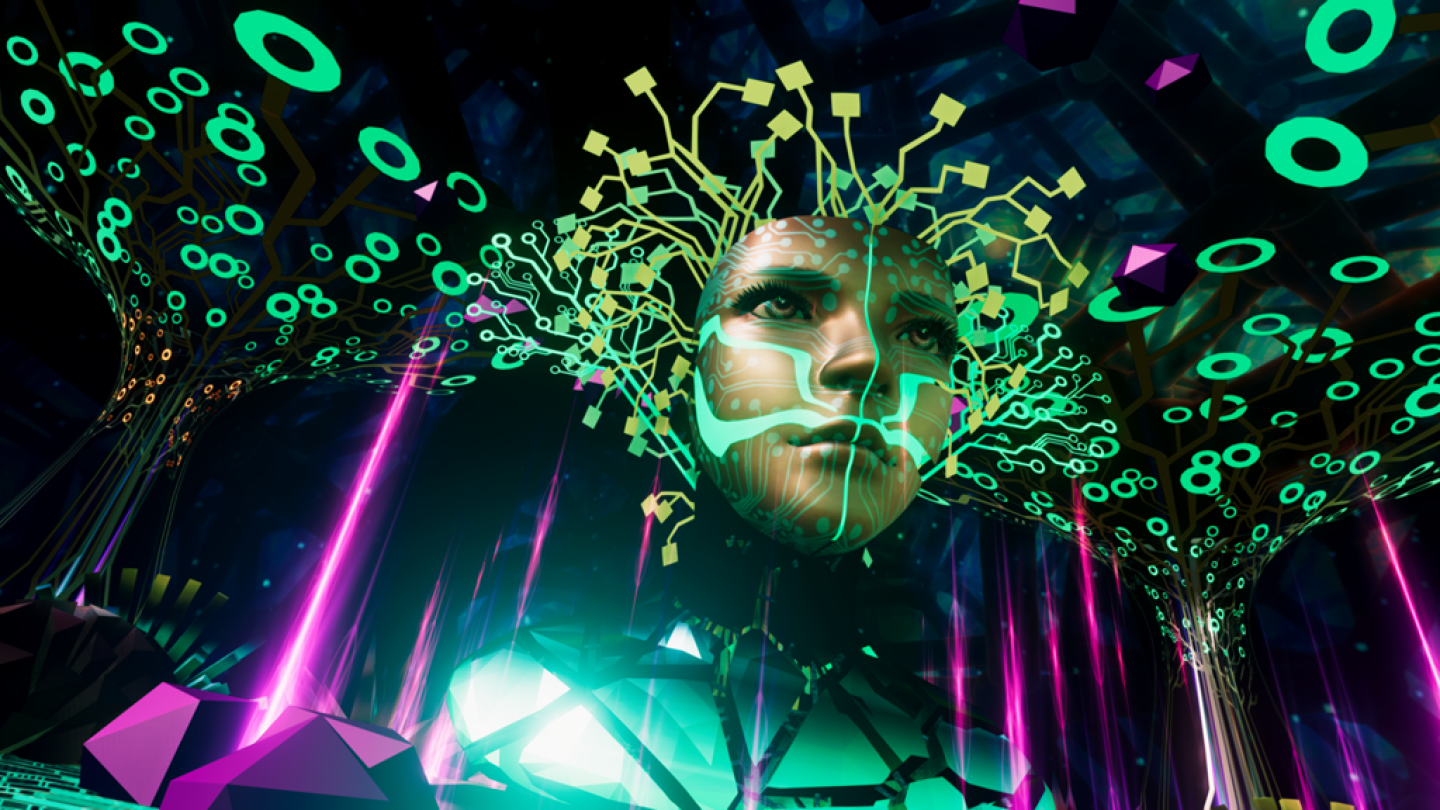(Editor’s note: This article is the latest installment in a series by Amazon Science delving into the science behind products and services of companies in which Amazon has invested. The Alexa Fund participated in TRIPP’s $11.2M Series A extension funding round in June 2022.)
With meditation soaring in popularity and the virtual reality (VR) industry booming, Alexa Fund portfolio company TRIPP is at the confluence of two powerful trends: mental well-being and VR. TRIPP is a digital wellness program that uses VR headsets to immerse users in breathing meditation experiences.
The idea to meld meditation and VR first occurred to TRIPP CEO and co-founder Nanea Reeves in 2017 when she, a lifelong practitioner of meditation with a 15-year career in the gaming industry, was experimenting with the medium by building a solitaire game in VR.

“The way I felt exploring VR was even more interesting to me than the actual development,” Reeves says. Her interest developed into a deep curiosity about the psychological effects of VR, and she began searching the scientific literature.
In addition to studying VR in medical and mental health use cases, she discovered work by Giuseppe Riva, a neuropsychologist whose research has shown that VR can elicit emotions such as awe and, in turn, influence people’s well-being, agency, and perceptions of themselves.
“Inspired by Giuseppe’s research, we wondered if we could create environments that make you go, ‘Oh, wow!’ and give you a lift,” Reeves explains. That became her impetus to found TRIPP in 2017, pursuing the hypothesis that, by stimulating experiences through VR, people may gain some agency over their emotions.
Riva’s work identified several aspects of VR that made it particularly effective for evoking awe, including its immersive nature and the complexity and scale of virtual environments.
“We started leaning into that, and we started to play with scale in our designs,” says Reeves.
In 2019, TRIPP launched its award-winning wellness application, TRIPP, in VR. The application offers immersive mindfulness experiences and, to date, has delivered nearly 6 million wellness sessions. TRIPP continues to work closely with neuroscience and psychiatry advisors through PsyAssist to design and evaluate their experiences and with a host of researchers who are studying its potential uses.
A recent clinical trial suggested that TRIPP might positively influence well-being and mood in cancer patients, and ongoing projects are assessing whether TRIPP can help people in recovery from substance use disorders or anxiety and pain control, among other initiatives.
“With some of the early data coming in, it seems very promising that tools like TRIPP might have a positive impact,” Reeves says, “but we are still only at the beginning of what may be possible with VR.”
Amazon Science spoke with Reeves about the motivation for TRIPP, its roots in science, and the implications for what it can achieve with VR.
- Q.
Why take meditation virtual?
A.It’s actually a super native case for VR, because the immersive quality allows you to unplug. You can’t look at your phone by nature of the immersion. I was blown away by how I felt moving in and out of VR — the feeling of respite.
A lot of the early VR experiences simulated environments that made you terrified, like walking a plank or standing at the edge of a cliff. And it occurred to me: if we could scare people so easily, could we trigger other emotional changes that are beneficial?
Our approach is to use immersion to drive a deeper connection to self-contemplative thoughts. You’re immersed in this psychologically safe container that is designed to capture your awareness, to allow you to be present and connect to self. With VR, it’s not just an audio file guiding you toward connecting with your breath. We can show you your breath, like star crystals coming in and out of your mouth.
Some of the early offerings thought VR was really only for gaming. When we first got TRIPP on Oculus, they didn’t know where to put us because they didn’t have a relaxation genre then. We were pretty buried in the store. But we started to get a little bit of traction, and we soon had surprisingly regular usage over time. VR has this problem where you go in, you go, “Wow, that was amazing!” and then it's in your closet. You never pick it up again. When we were designing the product, we knew we had to build for repeat usage. So, we built it procedurally, and now we can update it from the server and add new content regularly.
- Q.
How is science leading the design and development of TRIPP?
A.I started by looking at the research investigating VR’s effect on the brain, largely by neuroscientists and behavioral therapists exploring mental health and medical use cases for VR. Most of them focused on simulation, like simulated exposure therapy. But I wondered if, instead of simulating something, could we stimulate responses? I took that question to the researchers working on VR and its effects on mental well-being. We started digging into the research and then, based on the research data, designed VR experiences intended to trigger states of wonder and awe. We tried them out on people and captured some physiological data like heart rate and EEG to see if the experiences were directionally achieving the effect we wanted.
We stay very grounded in research-driven design choices. We’re a bit edgy. Rather than mimicking natural environments, the experiences are deliberately psychedelic. You find yourself inside an atom or floating in space. First, we tried things like a waterfall or a beach, but when we tested them, they didn’t feel good. I found some research describing how sensory dissonance in synthetic natural environments can create a stress response. Your brain goes, “Well, it looks like a beach, but I don’t smell the ocean. So what’s wrong with this environment?” We realized we had to create environments for which you have no mental model. So we said, “OK, let’s put you in a cosmic flotation tank, whatever that means, because no one knows what space smells like.”
We’re also starting an enterprise program to support employee wellness and team-building with a hybrid workforce, but also with a focus on using the metaverse for driving ideation and innovation. Can we use these otherworldly environments to spark creativity?
Nanea ReevesAfter we launched, we started collecting data on mood and emotional state in the live user sessions via self-reported surveys that are based on what they use in mental health research. We bookended our sessions with users, basically asking “How do you feel?” before and after each session. We did things like randomizing the order of the response selections to control against position bias. Now, we have data collected from close to 6 million sessions that we can slice and dice by the time of day and, for a percentage of our audience who opted in, age, gender, and location. It’s become a meaningful body of data that we can share with researchers once it has been de-identified. We also work with researchers who want to study TRIPP and its potential applications. It’s been fascinating to work with that community.
One example is this group in Germany working with cancer patients undergoing surgery, looking at the effects of TRIPP sessions on their quality of life, well-being, and mood. This study was published in Nature’s Scientific Reports. Participation was good, and patients who used TRIPP had lower heart rates and breathing rates after their sessions. They had improved scores on their mood and emotion surveys after the sessions too. What the study shows us is that VR-based relaxation is a viable option and may be beneficial for cancer patients undergoing surgery. Of course, we don’t make any therapeutic claims until we have a tremendous amount of evidence to support those claims.
You can find other published data and scientific reports examining TRIPP’s effects on adolescents and its use in palliative care. And we’re working with researchers who are looking at whether TRIPP could help people experiencing addiction and rehab, chemotherapy, severe mental illness, anxiety, and pain. Researchers are also using TRIPP to ease anxiety and help people prepare for ketamine-assisted therapy, so they get the most out of their treatment. I feel very motivated to see how we can help and participate in these research initiatives.
- Q.
How might TRIPP change how we use VR, beyond its medical applications?
A.Earlier this year, we acquired EvolVR, which holds live group meditations. Several hundred avatars attend the most popular conversations. People really open up. Skip Rizzo, PhD, a renowned researcher in the field and an advisor to TRIPP, did a pilot study and found that people suffering from PTSD were more open and honest with an avatar. We want to further investigate this as there’s something about the “digital veil” of VR where you don’t feel the judgment of being seen by other people. I think this is a wonderful use case for the metaverse.
We’re also starting an enterprise program to support employee wellness and team-building with a hybrid workforce, but also with a focus on using the metaverse for driving ideation and innovation. Can we use these otherworldly environments to spark creativity?
It’s also fascinating to think about the gig economy that could emerge from the metaverse — similar to what first emerged from mobile computing. For example, I met a woman at one of our live group meditation events in the metaverse who’s earning a living as one of the top world-builders in Altspace VR. She’s a mother of five who has never worked in tech before. She’s now a programmer, building these virtual worlds.
We’re only beginning to explore the potential of VR. It’s like the early days of mobile. Initially, no one thought we’d want to play games or even text message on our cell phones. Now, for the past decade, we have been walking around with our heads down staring at these phone screens nonstop. What kind of innovation will happen in a future when XR glasses are ubiquitous and allow us to experience the world around us in an entirely new and adaptive way?


















